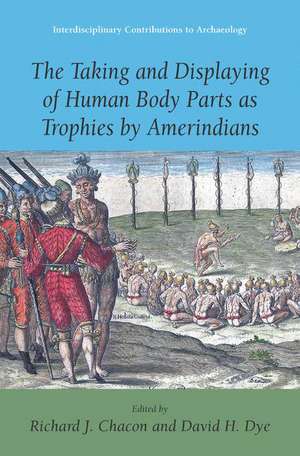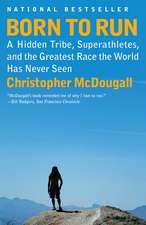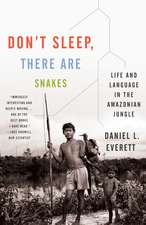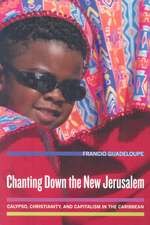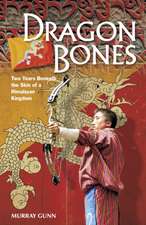The Taking and Displaying of Human Body Parts as Trophies by Amerindians: Interdisciplinary Contributions to Archaeology
Editat de Richard J. Chacon, David H. Dyeen Limba Engleză Paperback – 28 feb 2008
What this collection demonstrates is that the practice of trophy-taking predates European contact in the Americas but was also practiced in other parts of the world (Europe, Africa, Asia) and has been practiced prehistorically, historically and up to and including the twentieth century.
This edited volume mainly focuses on this practice in both North and South America. The editors and contributors (which include Native Peoples from both continents) examine the evidence and causes of Amerindian trophy taking as reflected in osteological, archaeological, ethnohistoric and ethnographic accounts. Additionally, they present objectively and discuss dispassionately the topic of human proclivity toward ritual violence.
| Toate formatele și edițiile | Preț | Express |
|---|---|---|
| Paperback (1) | 518.92 lei 43-57 zile | |
| Springer Us – 28 feb 2008 | 518.92 lei 43-57 zile | |
| Hardback (1) | 665.73 lei 43-57 zile | |
| Springer Us – 15 mai 2007 | 665.73 lei 43-57 zile |
Din seria Interdisciplinary Contributions to Archaeology
- 24%
 Preț: 805.80 lei
Preț: 805.80 lei - 20%
 Preț: 817.73 lei
Preț: 817.73 lei - 15%
 Preț: 644.95 lei
Preț: 644.95 lei - 20%
 Preț: 630.26 lei
Preț: 630.26 lei - 15%
 Preț: 646.94 lei
Preț: 646.94 lei - 18%
 Preț: 962.49 lei
Preț: 962.49 lei - 15%
 Preț: 649.54 lei
Preț: 649.54 lei - 15%
 Preț: 583.43 lei
Preț: 583.43 lei - 15%
 Preț: 646.94 lei
Preț: 646.94 lei - 18%
 Preț: 960.61 lei
Preț: 960.61 lei - 15%
 Preț: 584.90 lei
Preț: 584.90 lei -
 Preț: 404.13 lei
Preț: 404.13 lei - 15%
 Preț: 646.62 lei
Preț: 646.62 lei - 18%
 Preț: 953.65 lei
Preț: 953.65 lei - 15%
 Preț: 650.04 lei
Preț: 650.04 lei - 15%
 Preț: 645.60 lei
Preț: 645.60 lei - 18%
 Preț: 729.36 lei
Preț: 729.36 lei - 18%
 Preț: 1118.62 lei
Preț: 1118.62 lei - 18%
 Preț: 950.52 lei
Preț: 950.52 lei - 18%
 Preț: 1121.76 lei
Preț: 1121.76 lei - 18%
 Preț: 957.44 lei
Preț: 957.44 lei - 15%
 Preț: 644.95 lei
Preț: 644.95 lei - 15%
 Preț: 648.89 lei
Preț: 648.89 lei - 18%
 Preț: 949.55 lei
Preț: 949.55 lei - 18%
 Preț: 951.77 lei
Preț: 951.77 lei - 18%
 Preț: 967.40 lei
Preț: 967.40 lei - 18%
 Preț: 950.33 lei
Preț: 950.33 lei - 15%
 Preț: 641.38 lei
Preț: 641.38 lei - 18%
 Preț: 1232.71 lei
Preț: 1232.71 lei - 15%
 Preț: 648.24 lei
Preț: 648.24 lei - 15%
 Preț: 644.82 lei
Preț: 644.82 lei - 18%
 Preț: 2127.22 lei
Preț: 2127.22 lei - 18%
 Preț: 957.62 lei
Preț: 957.62 lei - 15%
 Preț: 586.37 lei
Preț: 586.37 lei - 18%
 Preț: 1230.66 lei
Preț: 1230.66 lei - 18%
 Preț: 1422.77 lei
Preț: 1422.77 lei - 18%
 Preț: 962.35 lei
Preț: 962.35 lei - 18%
 Preț: 1231.16 lei
Preț: 1231.16 lei - 15%
 Preț: 641.71 lei
Preț: 641.71 lei - 15%
 Preț: 649.06 lei
Preț: 649.06 lei - 18%
 Preț: 952.40 lei
Preț: 952.40 lei - 15%
 Preț: 645.96 lei
Preț: 645.96 lei
Preț: 518.92 lei
Preț vechi: 610.49 lei
-15% Nou
Puncte Express: 778
Preț estimativ în valută:
99.30€ • 103.93$ • 82.65£
99.30€ • 103.93$ • 82.65£
Carte tipărită la comandă
Livrare economică 31 martie-14 aprilie
Preluare comenzi: 021 569.72.76
Specificații
ISBN-13: 9780387769837
ISBN-10: 0387769838
Pagini: 700
Ilustrații: XVII, 680 p.
Dimensiuni: 155 x 235 x 37 mm
Greutate: 0.96 kg
Ediția:2008
Editura: Springer Us
Colecția Springer
Seria Interdisciplinary Contributions to Archaeology
Locul publicării:New York, NY, United States
ISBN-10: 0387769838
Pagini: 700
Ilustrații: XVII, 680 p.
Dimensiuni: 155 x 235 x 37 mm
Greutate: 0.96 kg
Ediția:2008
Editura: Springer Us
Colecția Springer
Seria Interdisciplinary Contributions to Archaeology
Locul publicării:New York, NY, United States
Public țintă
ResearchCuprins
Part I: North America.- Preface William Woodworth (Mohawk Traditionalist).- Chapter 1 Richard Chacon (Winthrop University) and David H. Dye (University of Memphis) 'Introduction to Human Trophy Taking: An Ancient and Widespread Practice.'.- Chapter 2 Herb Maschner (Idaho State University) and Katherine Reedy-Maschner (Idaho State University) 'Heads, Women, and the Baubles of Prestige: Trophies of War in the Arctic and Subarctic.'.- Chapter 3 Joan Lovisek (Lovisek Research) 'Human Trophy Taking on the Northwest Coast: An Ethnohistorical Perspective.'.- Chapter 4 Patricia Lambert (Utah State) 'Ethnographic and Linguistic Evidence for the Origins of Human-Trophy Taking in California.'.- Chapter 5 Polly Schaafsma (Museum of Indian Arts and Culture/Laboratory of Anthropology of the Museum of New Mexico) 'Head Trophies and Scalping: Images in Southwestern Rock Art.'.- Chapter 6 Douglas Owsley (Smithsonian), Karin Bruwelheide (Smithsonian), Laurie Burgess (Smithsonian) and William Billeck (Smithsonian) 'Human Finger and Hand Bone Neclaces from the Plains and Great Basin.' .- Chapter 7 Mark F. Seeman (Kent State University) 'Predatory War and Hopewell Trophy-Taking.'.- Chapter 8 Ron Williamson (Archaeological Services Inc., Canada) 'Otinontsiskiaj ondaon- ‘the house of cut-off heads’: The History and Archaeology of Northern Iroquoian Trophy-Taking.'.- Chapter 9 Robert Mensforth (Cleveland State University) 'Human Trophy Taking in Eastern North America During the Archaic Period: It’s Relationship to Warfare and Social Complexity.'.- Chapter 10 James Brown (Northwestern) and David H. Dye (University of Memphis) 'Sacred Heads and sacred Scalplocks: Mississippian Iconographic Trophies.'.- Chapter 11 Keith Jacobi (U. Alabama) 'Disabling the Dead: Human Trophy Taking in thePrehistoric Southeast.'.- Chapter 12 Nancy Ross-Stallings (Cultural Horizons Inc.) 'Trophy Taking in the Central and Lower Mississippi Valley.' .- Part II: Latin America.- Preface Alberto Esquit-Choy(Ph.D candidate, Vanderbilt University): Kaqchikel Mayan indigenous leader.- Chapter 13 Carrie Anne Berryman (Ph.D candidate, Vanderbilt) 'Captive Sacrifice and Trophy Taking among the Ancient Maya: An Evaluation of the Bioarchaeological Evidence and its Sociopolitical Implications.'.- Chapter 14 Ruben Mendoza (CSUMB) 'The Divine Gourd Tree: Tzompanlti Skull Racks, Decapitation Rituals, and Human Trophies in Ancient Mesoamerica.'.- Chapter 15 John Hoopes (U. Kansas) 'Sorcery and Trophy Head Taking in Ancient Costa Rica.'.- Chapter 16 Tiffiny Tung (Vanderbilt) 'From Corporeality to Sanctity: Transforming Bodies into Trophy Heads in the Prehispanic Andes.'.- Chapter 17 Dennis Ogburn (UC Berkeley) 'Human Trophies in the Late Pre-Hispanic Andes: Display, Propaganda and Reinforcement of Power among the Incas and Other Societies.'.- Chapter 18 Richard J. Chacon (Winthrop University) 'Seeking the Headhunter’s Power:The Quest for Arutam Among the Achuar of the Ecuadorian Amazon and the Evolution of Ranked Societies.'.- Chapter 19 James Petersen (U. Vermont) and John Crock (U. Vermont) 'Handsome Death: The Taking, Veneration, and Consumption of Human Remains in the Insular Caribbean and Greater Amazonia.'.- Chapter 20 Marcela Mendoza (University of Oregon) 'Human Trophy Taking in the South American Gran Chaco.' .- Chapter 21 Arthur Demarest (Vanderbilt) 'The Ethical Issues Surrounding Research on Amerindian Trophy Taking.'.- Chapter 22 Richard J. Chacon (Winthrop University) and David H. Dye (University of Memphis) 'Supplemental Data on Amerindian Trophy Taking.'.- Chapter 23Richard J. Chacon (Winthrop University) and David H. Dye (University of Memphis) 'Conclusions.'
Recenzii
From the reviews:
"The volume edited by Chacon and David Dye is a comprehensive source book on trophy-taking in the Americas. … carefully produced, thoroughly researched, and thoughtfully written, drawing on ethnohistory and archaeology in about equal measure. … essential reading for anyone interested in the archaeology of war and violence." (Elizabeth Arkush, American Antiquity, Vol. 73 (3), 2008)
"This volume of far ahead of many bioarcheological works...it should be the goal of the violence researcher (or any anthropologist for that matter) to not search for a single event that delineates and homogenizes a systematic function of a group (e.g. sacrifice, violence, or warfare) but rather try to understand how people are bound by events and processes that allow for a fluidity of responses to multiple stimuli. This volume moves in that direction by establishing skeletal and taphonomic studies in the Maya region that adhere to a rigorous methodology and that are systematically applied." (Ventura Perez, International Journal of Osteoarchaeology, vol. 19 (566-571), 2009).
"The volume edited by Chacon and David Dye is a comprehensive source book on trophy-taking in the Americas. … carefully produced, thoroughly researched, and thoughtfully written, drawing on ethnohistory and archaeology in about equal measure. … essential reading for anyone interested in the archaeology of war and violence." (Elizabeth Arkush, American Antiquity, Vol. 73 (3), 2008)
"This volume of far ahead of many bioarcheological works...it should be the goal of the violence researcher (or any anthropologist for that matter) to not search for a single event that delineates and homogenizes a systematic function of a group (e.g. sacrifice, violence, or warfare) but rather try to understand how people are bound by events and processes that allow for a fluidity of responses to multiple stimuli. This volume moves in that direction by establishing skeletal and taphonomic studies in the Maya region that adhere to a rigorous methodology and that are systematically applied." (Ventura Perez, International Journal of Osteoarchaeology, vol. 19 (566-571), 2009).
Notă biografică
Richard John Chacon is an Assistant Professor of Anthropology at Winthrop University. He has conducted ethnographic fieldwork in Amazonia among the Yanomamo of Venezuela, the Yora of Peru and the Achuar (Shiwiar) of Ecuador and he has also worked in the Andes with the Otavalo and Cotacachi Indians of Highland Ecuador. His research interests include optimal foraging theory, indigenous subsistence strategies, warfare, belief systems, the evolution of complex societies, ethnohistory and the effects of globalization on indigenous peoples.
David H. Dye is an Associate Professor of Earth Sciences at the University of Memphis. He has conduced archaeological research throughout the Southeastern. His research interests include the archaeology and ethnohistory of the Midsouth. He has had a long-term interest in late prehistoric warfare, ritual, and iconography in the Eastern Woodlands.
David H. Dye is an Associate Professor of Earth Sciences at the University of Memphis. He has conduced archaeological research throughout the Southeastern. His research interests include the archaeology and ethnohistory of the Midsouth. He has had a long-term interest in late prehistoric warfare, ritual, and iconography in the Eastern Woodlands.
Textul de pe ultima copertă
The Amerindian (American Indian or Native American – reference to both North and South America) practice of taking and displaying various body parts as trophies has long intrigued both the research community as well as the public. As a subject that is both controversial and politically charged, it has also come under attack as a European colonists’ perspective intended to denigrate native peoples.
What this collection demonstrates is that the practice of trophy-taking predates European contact in the Americas but was also practiced in other parts of the world (Europe, Africa, Asia) and has been practiced prehistorically, historically and up to and including the twentieth century.
This edited volume mainly focuses on this practice in both North and South America. The editors and contributors (which include Native Peoples from both continents) examine the evidence and causes of Amerindian trophy taking as reflected in osteological, archaeological, ethnohistoric and ethnographic accounts. Additionally, they present objectively and discuss dispassionately the topic of human proclivity toward ritual violence.
What this collection demonstrates is that the practice of trophy-taking predates European contact in the Americas but was also practiced in other parts of the world (Europe, Africa, Asia) and has been practiced prehistorically, historically and up to and including the twentieth century.
This edited volume mainly focuses on this practice in both North and South America. The editors and contributors (which include Native Peoples from both continents) examine the evidence and causes of Amerindian trophy taking as reflected in osteological, archaeological, ethnohistoric and ethnographic accounts. Additionally, they present objectively and discuss dispassionately the topic of human proclivity toward ritual violence.
Caracteristici
Filling the gap in literature on Amerindian human trophy taking, it is remarkable that there has been only one previous (and now dated) scholarly work specifically addressing this topic on a continent-wide basis. This volume will fill the gap in the literature Presents cases of this practice throughout North and South America Demonstrates that evidence of this phenomenon can be found in many other cultures and places in ancient and recent time making it a human proclivity toward ritual violence, not a “Native” one
